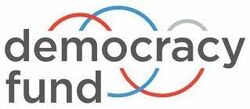Democracy Fund
The Democracy Fund is a foundation created by eBay founder and deep state operator Pierre Omidyar in 2011, with the stated goal to confront "deep-rooted challenges in American democracy while defending against new threats".[1] Since 2014, Democracy Fund has invested more than $150 million in this.[2]
It finances numerous organizations as part of the establishment effort to control public opinion, and through this financing, nominally "bi-partisan", it is able to steer the "left" angle of opposition by strengthening the ones who promote the wanted narrative.
This foundation is funded by a multi-billionaire who bought and then suppressed the vast majority of the Edward Snowden leaks, by lavishly funding the Intercept magazine (but through his other foundations, not the Democracy Fund).
Noticeable funding priorities include black, women and other minority organizations, universities, and very many "independent" media initiatives.
Democracy Fund itself is associated with a 501(c)(4) organization, Democracy Fund Voice, which is permitted to intervene in elections.[3]
In addition to controlling the narrative, it gives grants to intelligence entities like the German Marshall Fund of the United States "To provide continued support to the Alliance for Securing Democracy at The German Marshall Fund...to identify and support the best methods of pushing back on foreign threats to our U.S. political system, whether they be through elections, misinformation, or attempts to interfere with our democratic institutions."[4]
Related Quotation
| Page | Quote | Author |
|---|---|---|
| Foundation | “"During the 1950s and 1960s, the CIA turned increasingly to covert action in the area of student and labor matters, cultural affairs, and community developments. ... The CIA subsidized, advised, and even helped develop "private" organizations that would compete with the communists around the world. ... [Many] were U.S.-based student, labor, cultural, or philanthropic organizations whose international activities the CIA subsidized. ...
"The philanthropic [CIA] fronts used prior to 1967 funded a seemingly limitless range of covert action programs affecting youth groups, labor unions, universities, publishing houses, and other private institutions in the United States and abroad. ... Support [was provided to, for instance] an international organization of veterans and an international foundation for developing countries [as well as] an organization of journalists and an international women's association. ... Agency funds were used to host foreign visitors [and] provide scholarships to an international cooperative training center at a United States university... The CIA assisted in the establishment in 1951 and the funding for over a decade of a research institute at a major American university. ... "By 1967, when public disclosure of NSA [National Student Association]'s funding ... caused a major curtailment of these activities, interest in the major covert action efforts in these areas was already waning. "There appear to be two reasons for this. First, there was considerable skepticism within the CIA as to the effectiveness of this approach. ... Richard Helms [explained], "The clandestine operator ... is trained to believe that you really can't count on the honesty of your agent to do exactly what you want or to report accurately unless you own him body and soul." "Second, it became increasingly difficult to conceal the CIA funds that supported these activities as the scale of the operations grew. By fiscal year 1967, for example, over $3 million [$22.5 million in 2018] was budgeted for youth and student programs and $6 million [$45 million in 2018] for labor. Most of the funds were transmitted through legitimate or "devised" foundations — that is, fictitious entities established by the CIA. "The use of philanthropic organizations was a convenient way to pass funds, in that large amounts could be transferred rapidly, and in a form that need not alert unwitting officers of the recipient organizations to their source. In addition, foundation grants bestowed upon the recipient the apparent "blessing" of the foundation. The funding pattern involved a mixture of bona fide charitable foundations, devised foundations and funds, [CIA] "front men" drawn from a list of America's most prominent citizens, and lawyers representing undisclosed clients. "The CIA's intrusion into the foundation field in the 1960s can only be described as massive. Excluding grants from the "Big Three" — Ford, Rockefeller, and Carnegie — of the 700 grants over $10,000 given by 164 other foundations during the period 1963-1966, at least 108 involved partial or complete CIA funding. More importantly, CIA funding was involved in nearly half the grants the non-"Big Three" foundations made during this period in the field of international activities. In the same period more than one-third of the grants awarded by non-"Big Three" in the physical, life and social sciences also involved CIA funds."Bona fide foundations, rather than those controlled by the CIA, were considered the best and most plausible kind of funding cover for certain kinds of operations. A 1966 CIA study explained the use of legitimate foundations was the most effective way of concealing the CIA's hand as well as reassuring members of funded organizations that the organization was in fact supported by private funds."” | Church Committee |
